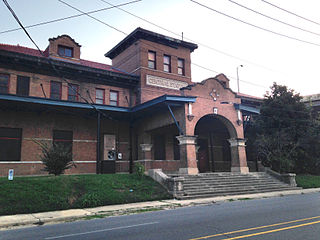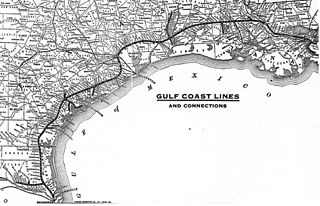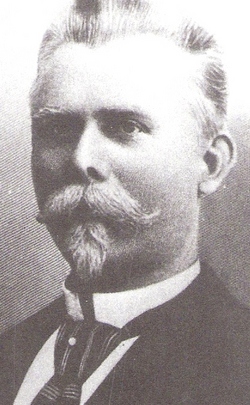
The Kansas City Southern Railway Company was an American Class I railroad. Founded in 1887, it operated in 10 Midwestern and Southeastern U.S. states: Illinois, Missouri, Kansas, Oklahoma, Arkansas, Tennessee, Alabama, Mississippi, Louisiana and Texas. KCS had the shortest north-south rail route between Kansas City, Missouri, and several key ports along the Gulf of Mexico.

Kansas City Southern (KCS) was a transportation holding company with railroad investments in the United States, Mexico, and Panama that existed from 1887 to 2023. The KCS rail network included about 7,299 miles (11,747 km) of track in the U.S. and Mexico.

The Crescent is a daily long-distance passenger train operated by Amtrak between New York City and New Orleans. The 1,377-mile (2,216 km) route connects the Northeast to the Gulf Coast via the Appalachian Piedmont, with major stops in Charlotte, North Carolina; Atlanta, Georgia; and Birmingham, Alabama.

The Missouri Pacific Railroad, commonly abbreviated as MoPac, was one of the first railroads in the United States west of the Mississippi River. MoPac was a Class I railroad growing from dozens of predecessors and mergers. In 1967, the railroad operated 9,041 miles of road and 13,318 miles of track, not including DK&S, NO&LC, T&P, and its subsidiaries C&EI and Missouri-Illinois.

The Texarkana and Fort Smith Railway was the Texas subsidiary of the Kansas City Southern Railway, operating railroad lines in the states of Arkansas and Texas, with headquarters at Texarkana, Texas.

The Southern Belle was a named passenger train service offered by Kansas City Southern Railway (KCS) from the 1940s through the 1960s, running between Kansas City, Missouri, and New Orleans, Louisiana.

The St. Louis Southwestern Railway Company, known by its nickname of "The Cotton Belt Route" or simply "Cotton Belt", is a former Class I railroad that operated between St. Louis, Missouri, and various points in the U.S. states of Arkansas, Tennessee, Louisiana, and Texas from 1891 to 1980, when the system added the Rock Island's Golden State Route and operations in Kansas, Oklahoma, and New Mexico. The Cotton Belt operated as a Southern Pacific subsidiary from 1932 until 1992, when its operation was assumed by Southern Pacific Transportation Company.
Stuart R. Knott was the fourth president of Kansas City Southern Railway.

Harvey Crowley Couch, Sr., was an Arkansas entrepreneur who rose from modest beginnings to control a regional utility and railroad empire. He is regarded as the father of Arkansas Power and Light Company and other electric utilities now part of Entergy; he helped mold the Louisiana and Arkansas Railway and the Kansas City Southern Railway into a major transportation system. His work with local and federal government leaders during World War I and the Great Depression gained him national recognition and earned him positions in state and federal agencies. He also established Arkansas' first commercial broadcast radio station.
The Fort Smith and Western Railway was a railroad that operated in the states of Arkansas and Oklahoma.

The Texas and New Orleans Railroad was a railroad in Texas and Louisiana. It operated 3,713 miles (5,975 km) of railroad in 1934; by 1961, 3,385 miles (5,448 km) remained when it merged with parent company Southern Pacific.
The MidSouth Rail Corporation is a railroad line operated by Kansas City Southern Railway (KCS) as a result of the January 1, 1994, acquisition; KCS began operating over MidSouth's line on January 11, 1994. The line ran from Shreveport, Louisiana, going east across Louisiana, and across the state of Mississippi, running through the cities of Vicksburg, Jackson, Meridian, and Artesia, Mississippi, then across the Alabama state line to Tuscaloosa, and finally into Birmingham. Midsouth had two other branches, with one to Counce, Tennessee, and a disconnected line from Gulfport to Hattiesburg, Mississippi. Total mileage was 1,212 miles (1,951 km) worth of mostly former Illinois Central Gulf's east-west Shreveport - Meridian main line.
The Meridian Speedway is a 320-mile (510 km) span of railroad track between Shreveport, Louisiana and Meridian, Mississippi. An important rail link between the Southeastern and Southwestern United States, it is operated as a joint venture of Canadian Pacific Kansas City (CPKC), which owns 70% of the partnership; and Alabama Great Southern Railroad, a subsidiary of Norfolk Southern Railway (NS).

The Queen and Crescent Route was a cooperative railroad route in the Southeastern U.S., connecting Cincinnati with New Orleans and Shreveport. Inaugurated in the 1880s, the name was retained by Southern Railway when they consolidated ownership of the entire route in 1926, and given to their named passenger train for the route through 1949.

The Alabama Great Southern Railroad is a railroad in the U.S. states of Alabama, Georgia, Louisiana, Mississippi, and Tennessee. It is an operating subsidiary of the Norfolk Southern Corporation (NS), running southwest from Chattanooga to New Orleans through Birmingham and Meridian. The AGS also owns about a 30% interest in the Kansas City Southern-controlled Meridian-Shreveport Meridian Speedway.

Shreveport Central Station is a historic train station in Shreveport, Louisiana. It was built in 1910 by the Louisiana and Arkansas Railroad, a railroad that was eventually acquired by the Kansas City Southern Railway. By the opening of the 1940s the L&A and the St. Louis Southwestern Railway or 'Cotton Belt' moved its passenger operations from Central Station to Shreveport Union Station.

The Gulf Coast Lines was the name of a railroad system comprising three principal railroads, as well as some smaller ones, that stretched from New Orleans, Louisiana, via Baton Rouge and Houston to Brownsville, Texas. Originally chartered as subsidiaries of the Frisco Railroad, the system became independent in 1916 and was purchased by the Missouri Pacific Railroad in 1925.

William C. Edenborn (1848–1926) was an inventor, steel industrialist, and railroad magnate. He patented the design for a machine for inexpensive manufacture of barbed wire. Edenborn founded the Louisiana Railway and Navigation Company, which operated between Shreveport, Louisiana, and New Orleans, Louisiana. Through a series of mergers and acquisitions, this railroad formed the Louisiana and Arkansas Railroad and eventually part of the Kansas City Southern Railroad.
Shreveport Union Station was a passenger station on Louisiana Avenue, at Lake Street, Shreveport, Louisiana. Built in 1897 by the Kansas City, Shreveport & Gulf Terminal Company, it was the oldest of Shreveport's four passenger railroad stations. With a tall tower, the station became a landmark in downtown Shreveport. It had its highest levels of service in the 1920s, typically hosting 35 passenger trains a day.

















